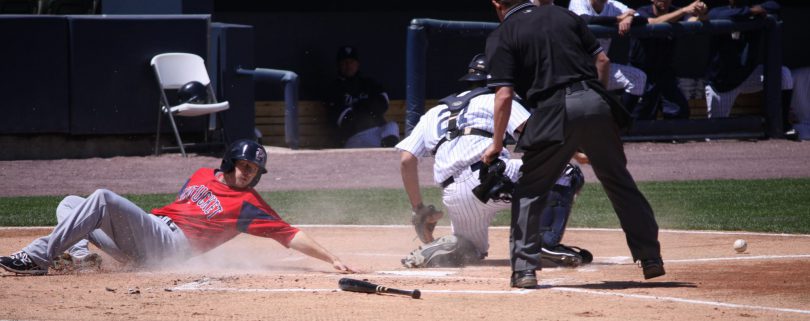The Situation:
The bases are loaded with 2 outs in the top of the 4th inning in a playoff game. It’s a hot, dry day and the pitcher has already given up 2 runs in the inning. He has also hit two batters in the inning and just walked the last hitter to load the bases. With the score 6-2, this is an opportunity for the offense to get back into the game. The batter has a 2-0 count as the pitcher comes set.
The Play:
The pitch is nowhere close to the zone and in the dirt. Despite his best attempt, the catcher can’t block the ball and it goes to the short backstop. The runner at 3rd, who had a short primary lead and average secondary lead reads the wild pitch and immediately heads for home.
The Outcome:
The backstop is a short distance from home and has padding. The wild pitch strikes the backstop firmly, ricochets and rolls back towards the catcher. The catcher slides to the ball, gathers it and quickly throws a perfect dart to the covering pitcher. The defense has executed the play flawlessly, and despite a hard slide, the runner from third is out easily. The inning and the threat are over.
What Went Wrong:
This is a very situational Think the Game scenario. There is a lot to take into account when deciding how aggressive to be and is another situation that would benefit from the offense having a running system that dictates how aggressive the runners should be in a given situation. A stoplight Red (not aggressive/no risks), Yellow (medium aggressive/go if you think you can make it), Green (most aggressive/if you have a chance to go then go) approach works well for aggressiveness on balls in the dirt.
With a 2-0 count turning to 3-0 on the wild pitch and fact that the pitcher has given up several free passes in the inning already, whether the coach puts on a Red Light or not, the runner at third needs to recognize the situation and weigh the risks and rewards. In this case, he should be very conservative in his attempts to score and give himself a Red Light approach. Here are all the indicators for not taking any risk:
- The backstop is close and balls rebound off of the padding hard (something that should be understood in pre-game preparation and discussed in pre-game)
- The pitcher has had a long inning and has not been throwing strikes regularly. He has already walked 1 and hit 2 batters this inning.
- There will be a 3-0 count. The offense is 1 ball away from walking home that run anyways.
- The pitcher has thrown a lot of pitches this inning, it is hot, and he is clearly laboring. Make him earn his way out of it.
- The runner at third is not anticipating the wild pitch and preparing for it with his primary and secondary leads. There is a big difference between reacting to a wild pitch versus anticipating it, preparing for it, and then reacting to it.
This may seem like a lot to consider for the runner at third, especially if there was no indication from a coach how aggressive he should be. In college, this type of thinking will be expected of you. There is feedback everywhere, and coaches will expect you to understand situations and include high level thinking in your in-game decision-making. This costly risk was not worth the reward and bailed the defense out of a tough jam.







